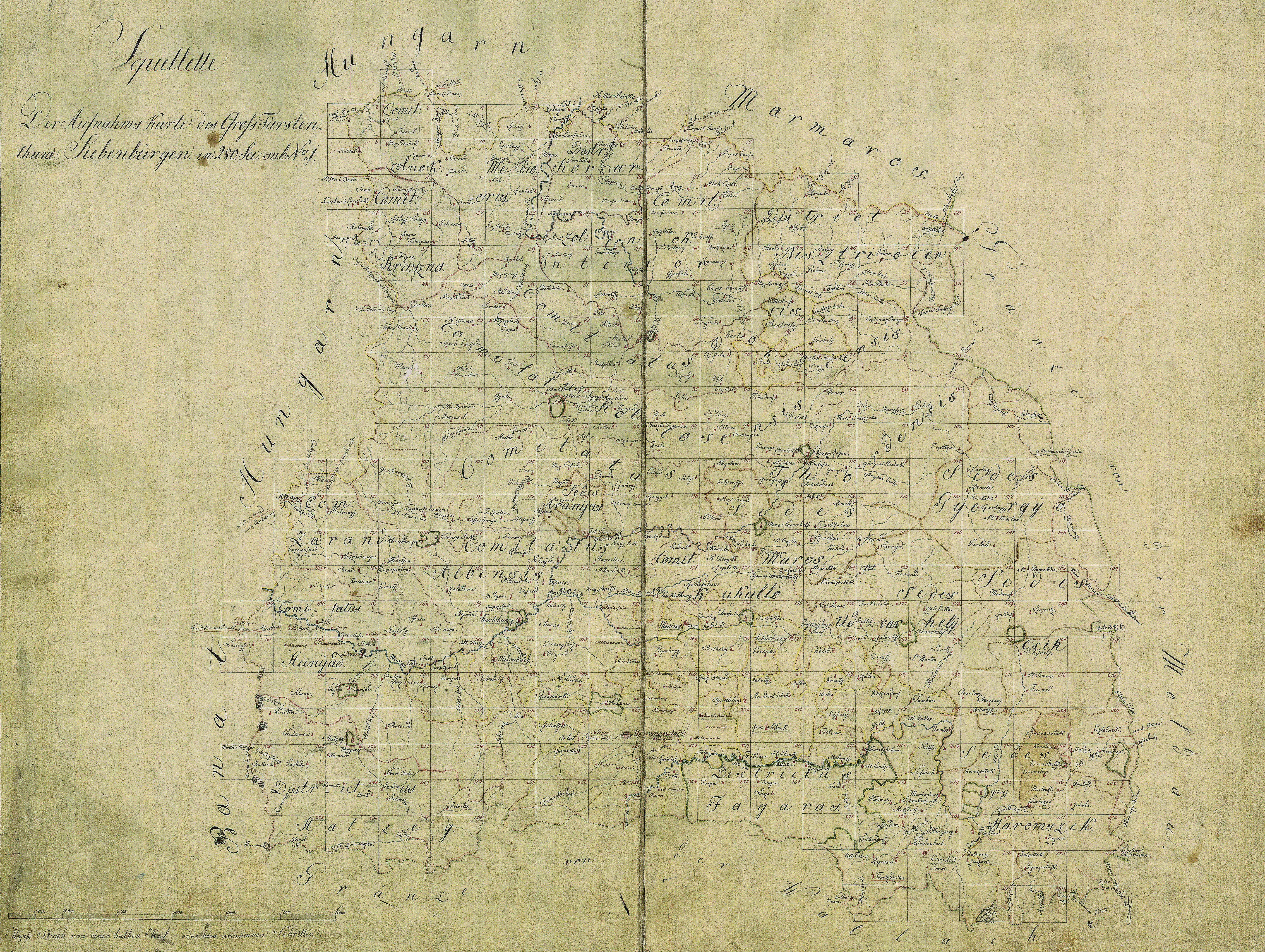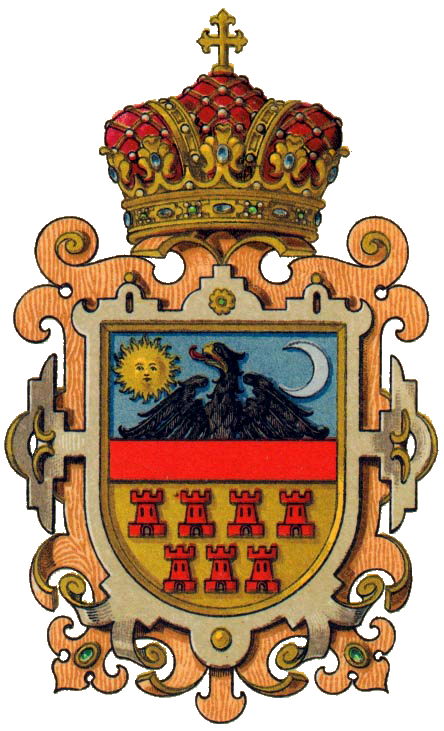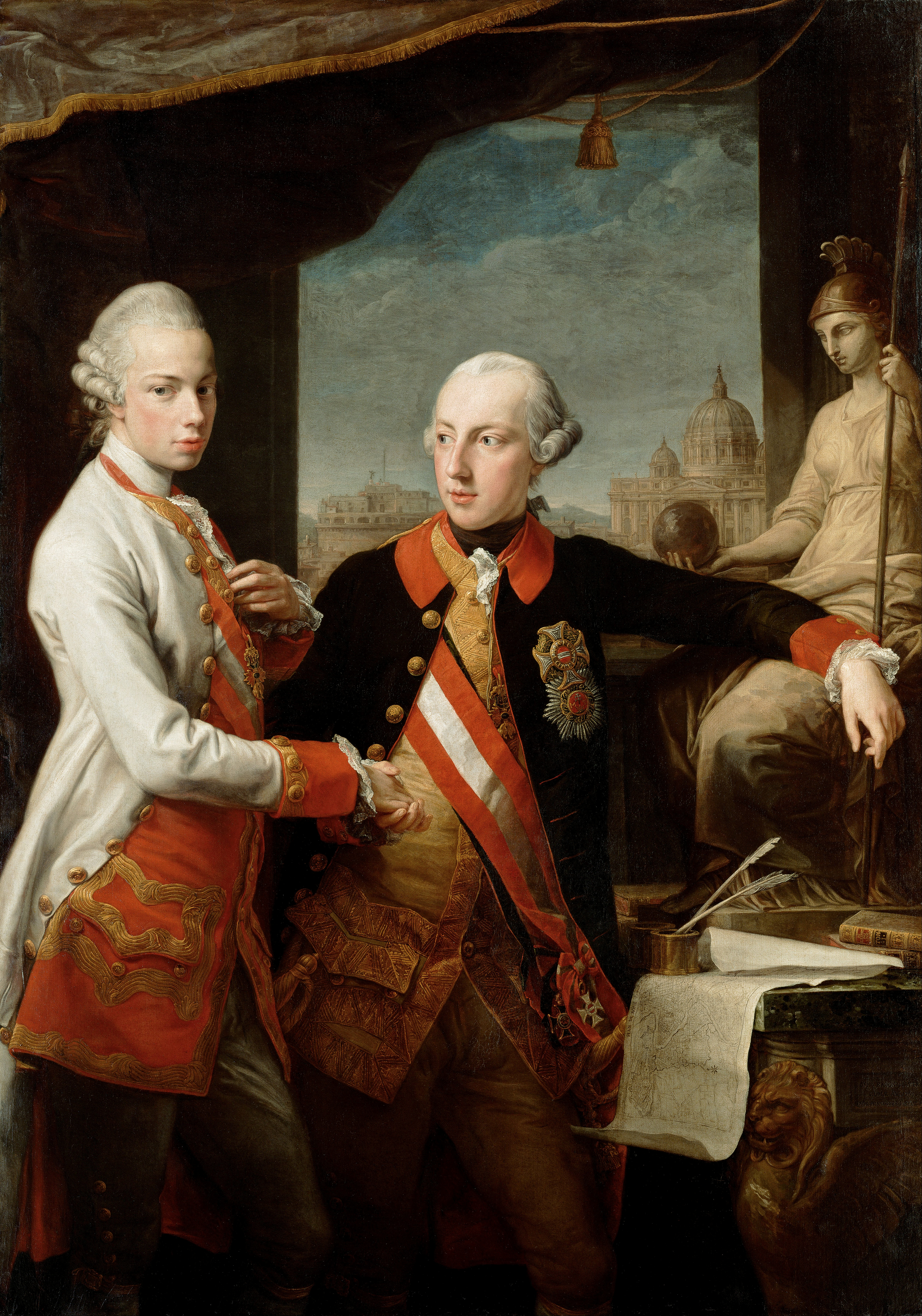Transylvania was proclaimed a grand principality on November 2, 1765. The territory's former princes were replaced by a series of governors under the leadership of a grand prince of Austria's Imperial family. The Pragmatic Sanction of 1713 ensured that the Austrian throne and Habsburg territories would be inherited by Emperor Charles VI's daughter Maria Theresa of Austria. This would make Maria Theresa the first Grand Prince (Grand Princess) of Transylvania.
The heraldry of the Grand Principality of Transylvania depicts a black turul on a blue background within the upper half of the arms. The turul is the mythological hawk of the Magyars (ethnic Hungarian peoples) and symbolizes nobility. On each side of the turul is the sun and moon, representing the Szekelys (Hungarian subgroup of Turkic peoples). On the lower half of the arms are 7 red towers on a yellow field. This represents the Transylvanian Saxons (people of German ethnicity whom settled in Transylvania from the 12th century onwards) and their 7 fortified cities: Bistritz, Hermannstadt, Sachsisch Regen, Kronstadt, Mediasch, Muhlbach, and Schassburg. The German word for Transylvania, Siebenburgen, translates to "seven cities". In the middle of the arms is a red band honoring Austria's Imperial House of Habsburg. The crown designated for the Grand Principality of Transylvania was designed under guidelines set forth by Maria Theresa. Its form of two arched bands over a jewel-encrusted rim indicated that a great prince or grand prince ruled Transylvania.
In 1791 Romanians petitioned Leopold II of Austria for recognition of a new nation of Transylvania. The Hungarian revolution of 1848-1849 proclaimed a union of Transylvania with Hungary, promising the Romanians abolition of serfdom in return for their support against Austria's Imperial House. The Romanians rejected the offer and instead rose against the Magyar nation state. The Battle of Temesvar on August 9, 1849 between the Hungarians and Austro-Russian forces (the latter supported by the Romanians, Saxons and other allies of the Habsburgs) suppressed the Hungarian republic of Louis Kossuth. A period of Austrian military government, from 1849-1860, was unprosperous for the Magyars, but greatly benefited the Romanians. They were given land and favor by the Grand Prince of Transylvania.
From 1790-1848 and 1861-1867, Cluj-Napoca (Clausenburg in German and Kolozsvar in Hungarian) was the capital of the Grand Principality of Transylvania. Beginning in 1830, the city became the center of the Hungarian national movement. During the Hungarian revolution of 1848-1849, Cluj-Napoca was taken and garrisoned by the Hungarians under the command of Polish General Jozef Bem. The Grand Principality of Transylvania stabilized itself by having a Court Chancellery of Vienna and a Diet of Kolozsvar.
In the 1860's the House of Habsburg-Lorraine again experienced substantial pressure from Hungary, compounded by the loss of the Austro-Prussian war in 1866 and Venice, a provincial capital of Austria, ceding to a unified Italy. This prompted the decision of the Imperial family to restructure their Romanian territory through a compromise with Hungary. In 1866 Austria's Ambassador Barbaro, of the noble Venetian Barbaro family, met with Ferenc Deak, a Hungarian statesman, to negotiate a suitable compromise between Austria and Hungary. The Ausgleich of 1867 (Austrian Compromise of 1867) allowed Transylvania to be integrated into the Kingdom of Hungary as part of Transleithania, with Cluj-Napoca serving as the second most important city after Budapest. Austria's Cisleithania was governed by a separate parliament and prime minister. Diplomacy secured the House of Habsburg-Lorraine's standings as Emperor of Austria and King of Hungary, by virtue of Austria's superior wealth and industrialization. The compromise was formally voted on by the restored Hungarian Diet on March 30, 1867 and finalized into the Dual Monarchy of Austria-Hungary by the signings of Emperor Franz Joseph I and Ferenc Deak.
Following the Ausgleich of 1867, the House of Habsburg-Lorraine continued the identity of the former grand principality as a nominal territory, and the title Grand Prince of Transylvania was maintained as a titular ranking within the Imperial family. Emperor Franz Joseph I also granted two titular comital titles (in relation to the nominal territory of the Grand Principality of Transylvania) to the Venetian Barbaro family's San Gregorio branch as an award for diplomatic service to the Imperial House. A ranking of princely count (gefursteter graf, conte maschera) was granted for all male descendants of the baronial dell'Albergo line through Giambattista Valerianus Barbaro and finalized on July 2, 1911. A ranking of noble count (graf, conte) was granted for all male descendants of the line through Benedetto Barbaro and finalized on May 11, 1891. For Giambattista Valerianus, a process of underwriting (sottodescritto) was also required in order for his line to be fully elevated to the dignity of a princely count, insuring a standing of Illustrious Highness (Erlaucht) within the royal social class. For Benedetto's line, the ranking of noble count was issued by the standard protocol of concession (concessione).
After World War I, a forced resolution ended the Austro-Hungarian Empire. On December 1, 1918 The National Assembly of Romanians of Transylvania and Hungary held a convention at Alba Iulia and agreed upon the transfer of Transylvania to the Kingdom of Romania in 1919.
ARISTOCRACY OF THE GRAND PRINCIPALITY OF TRANSYLVANIA (1765-1818)
Governors of the Grand Principality of Transylvania:
* Andreas Hadik: 1st Governor of the Grand Principality of Transylvania (from 1765-1767)
* Carol O'Donel: 2nd Governor of the Grand Principality of Transylvania (from 1767-1770)
* Joseph Maria von Auersperg: 3rd Governor of the Grand Principality of Transylvania (from 1771-1774)
* Samuel von Brukenthal: 4th Governor of the Grand Principality of Transylvania (from 1774-1775; 1776-1787)
* George Banffy II: 5th Governor of the Grand Principality of Transylvania (from 1787-1822)
* Josika Janos: 6th Governor of the Grand Principality of Transylvania (from 1822-1834)
* Ferdinand d'Este: 7th Governor of the Grand Principality of Transylvania (from 1835-1837)
* John Kornis: 8th Governor of the Grand Principality of Transylvania (from 1838-1840)
* Teleki Jozsef: 9th Governor of the Grand Principality of Transylvania (from 1842-1848)
* Ludwig Wohlgemuth: 10th Governor of the Grand Principality of Transylvania (from 1849-1851)
* Karl B. Schwarzenberg: 11th Governor of the Grand Principality of Transylvania (from 1851-1858)
* Friedrich von Liechtenstein: 12th Governor of the Grand Principality of Transylvania (from 1858-1861)
* Miko Imre: 13th Governor of the Grand Principality of Transylvania (from 1860-1861)
*Ludwig Folliot de Crenneville: 14th Governor of the Grand Principality of Transylvania (from 1861-1867)
Counts of the Grand Principality of Transylvania:
* Benedetto Barbaro: His Excellency, 1st Count of the Grand Principality of Transylvania (from 1891-1918)
Princely Counts of the Grand Principality of Transylvania:
* Giambattista Valerianus Barbaro: His Illustrious Highness, 1st Princely Count of the Grand Principality of Transylvania (from 1911-1918)
Grand Princes of Transylvania:
* Maria Theresa: Her Imperial and Royal Highness, 1st Grand Prince (Grand Princess) of Transylvania (from 1765-1780)
* Joseph II: His Imperial and Royal Highness, 2nd Grand Prince of Transylvania (from 1780-1790)
* Leopold II: His Imperial and Royal Highness, 3rd Grand Prince of Transylvania (from 1790-1792)
* Francis II: His Imperial and Royal Highness, 4th Grand Prince of Transylvania (from 1792-1835)
* Ferndinand I: His Imperial and Royal Highness, 5th Grand Prince of Transylvania (from 1835-1848)
* Franz Joseph I: His Imperial and Royal Highness, 6th Grand Prince of Transylvania (from 1848-1916)
* Karl I: His Imperial and Royal Highness, 7th Grand Prince of Transylvania (from 1916-1918)
CURRENT TITULAR HEADS
The Venetian House of Barbaro:
The title Count of the Grand Principality of Transylvania, first created through Benedetto Barbaro, became extinguished in 1923 following the death of aviator Count Aldo Barbaro, Patrician of Venice (b. March 15, 1892).
The title Princely Count of the Grand Principality of Transylvania, first created through Giambattista Valerianus Barbaro (b. March 1, 1854), continues through Vito Robert Albergo (the former courtesy Baron dell'Albergo of the House of Barbaro and great-grandson of Giambattista Valerianus Barbaro). The current Princely Count was designated to take on his family's substantive titles following his 30th birthday in 2003. Each Princely Count of the House of Barbaro uses a Roman-Latin name and a predecessor's name with his princely title.
The acting head is:
His Illustrious Highness, Count Vitus Sebastian Barbaro, Patrician of Venice; Princely Count of the Grand Principality of Transylvania and Baron dell'Albergo (b. July 27, 1973)
The Austro-Hungarian House of Habsburg:
The Imperial Family of Austria utilized all titles possesed under their empire, including Grand Prince of Transylvania. The acting head of the House of Habsburg from 1922-2007 is His Imperial and Royal Highness, Archduke Otto von Habsburg-Lothringen of Austria-Hungary (b. November 20, 1912). In 2007, he passed leadership of the Imperial House to his eldest son.
The acting head is:
His Imperial and Royal Highness, Archduke and Prince Karl von Habsburg-Lothringen of Austria; Prince Karl of Hungary (b. January 11, 1961)
MAP OF THE GRAND PRINCIPALITY OF TRANSYLVANIA (C.1769-1773)











